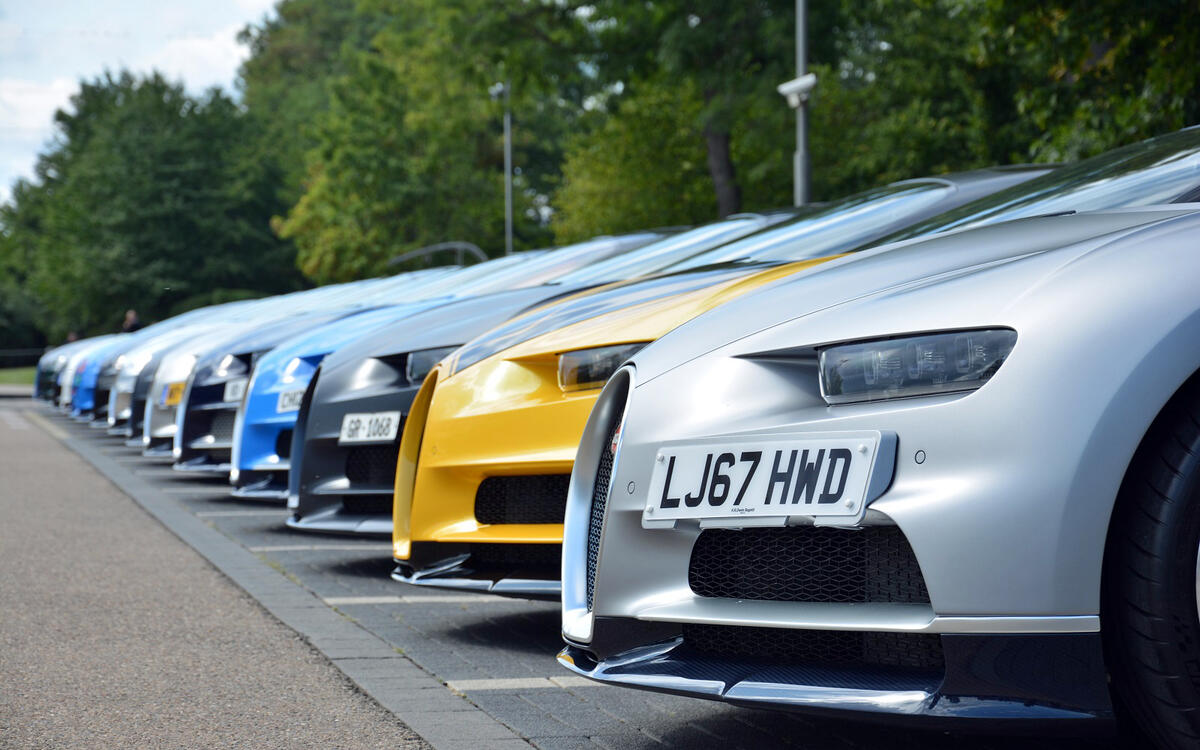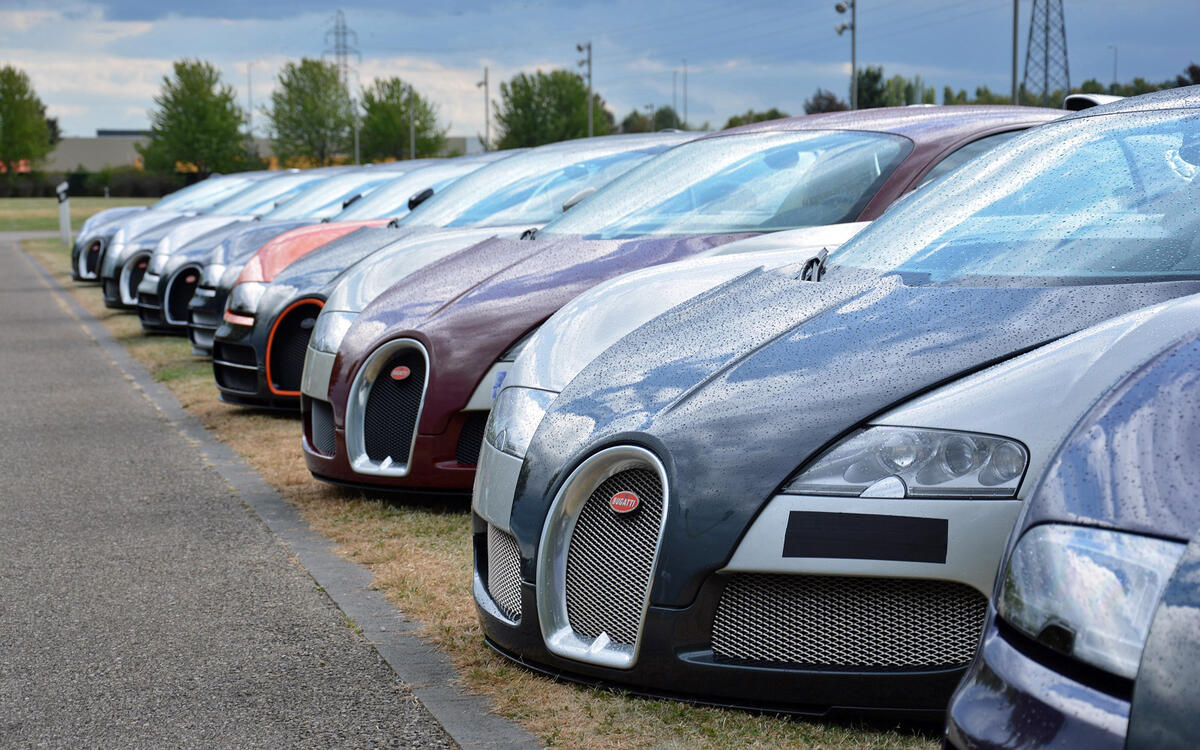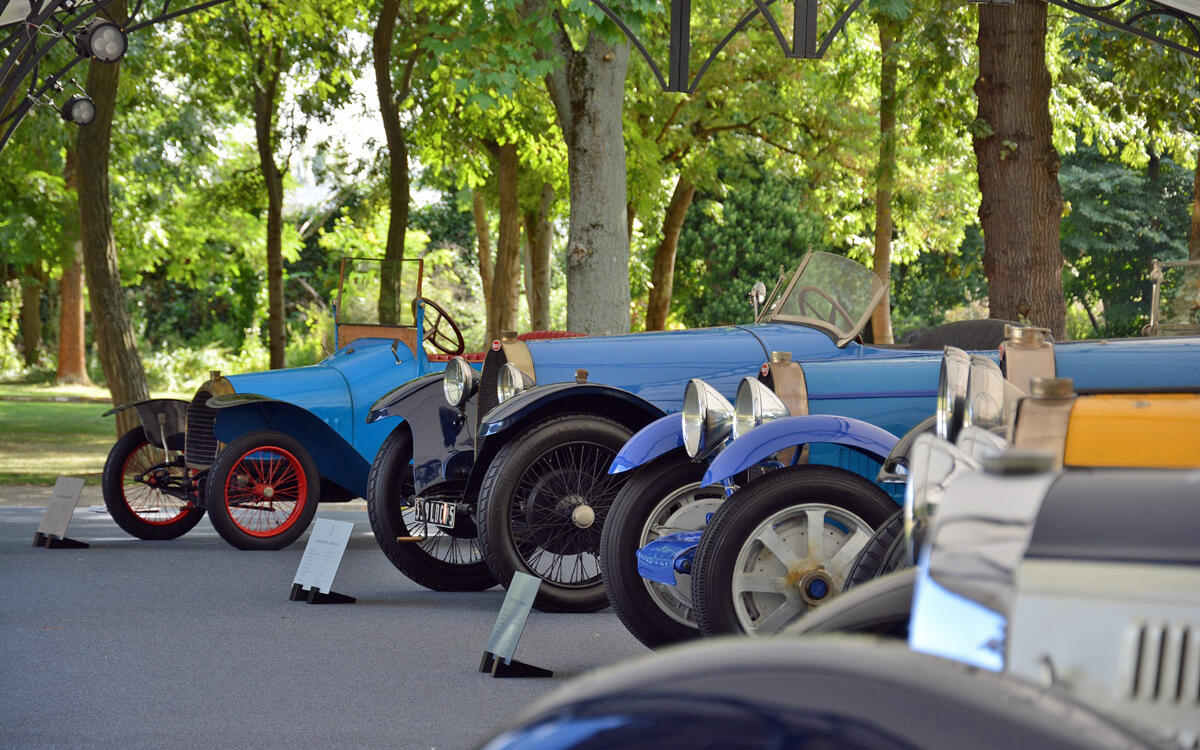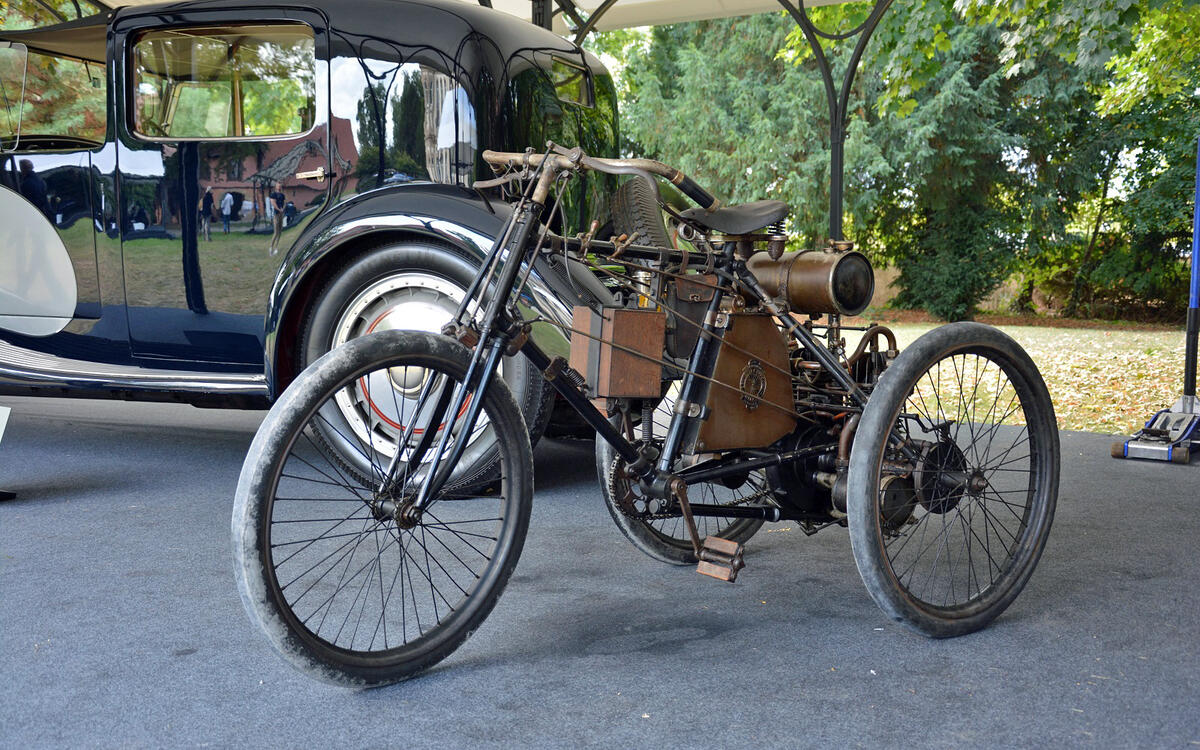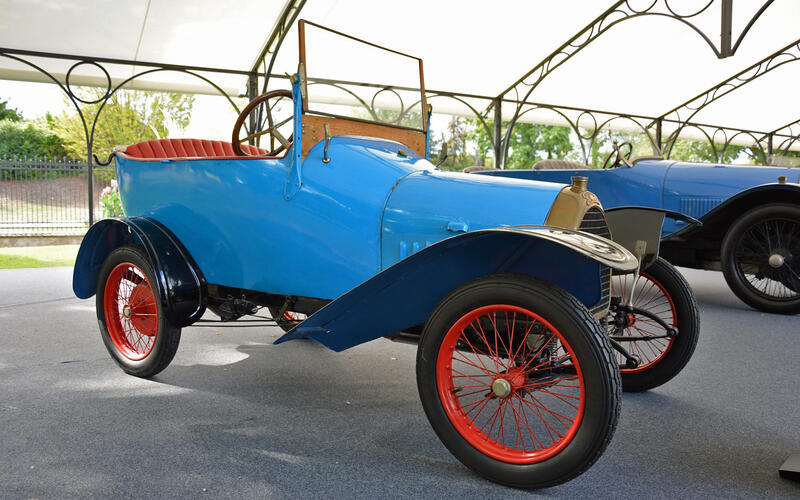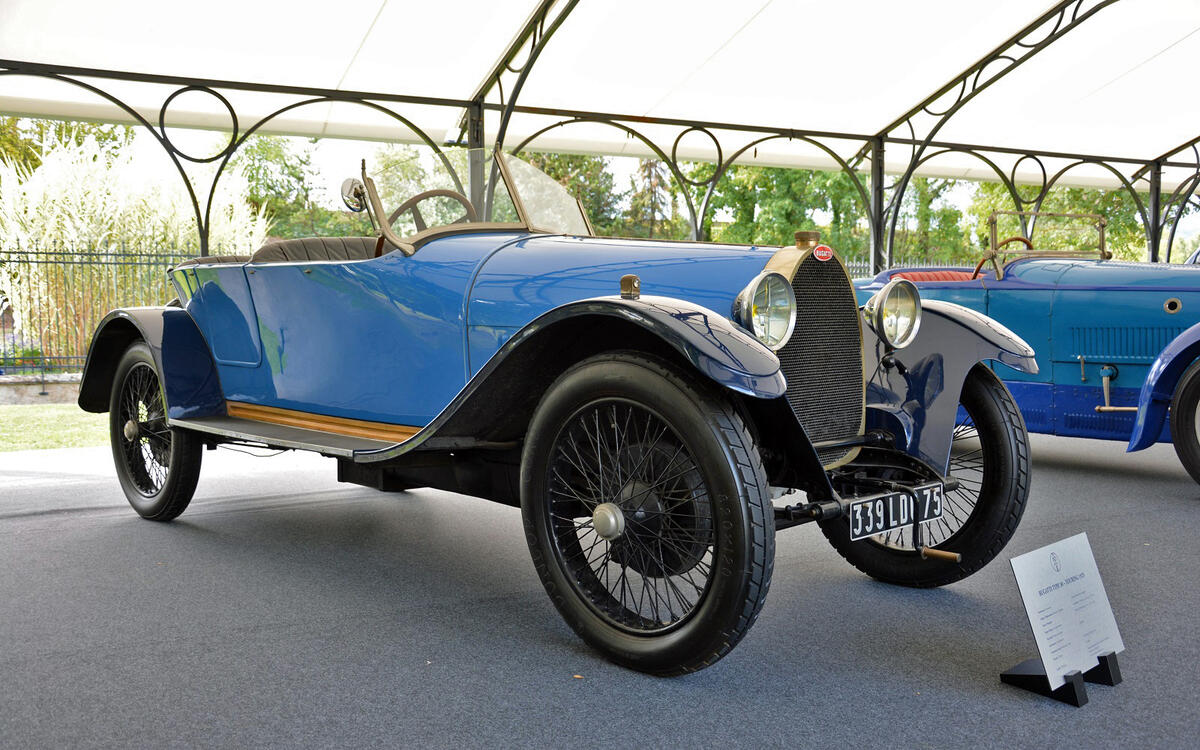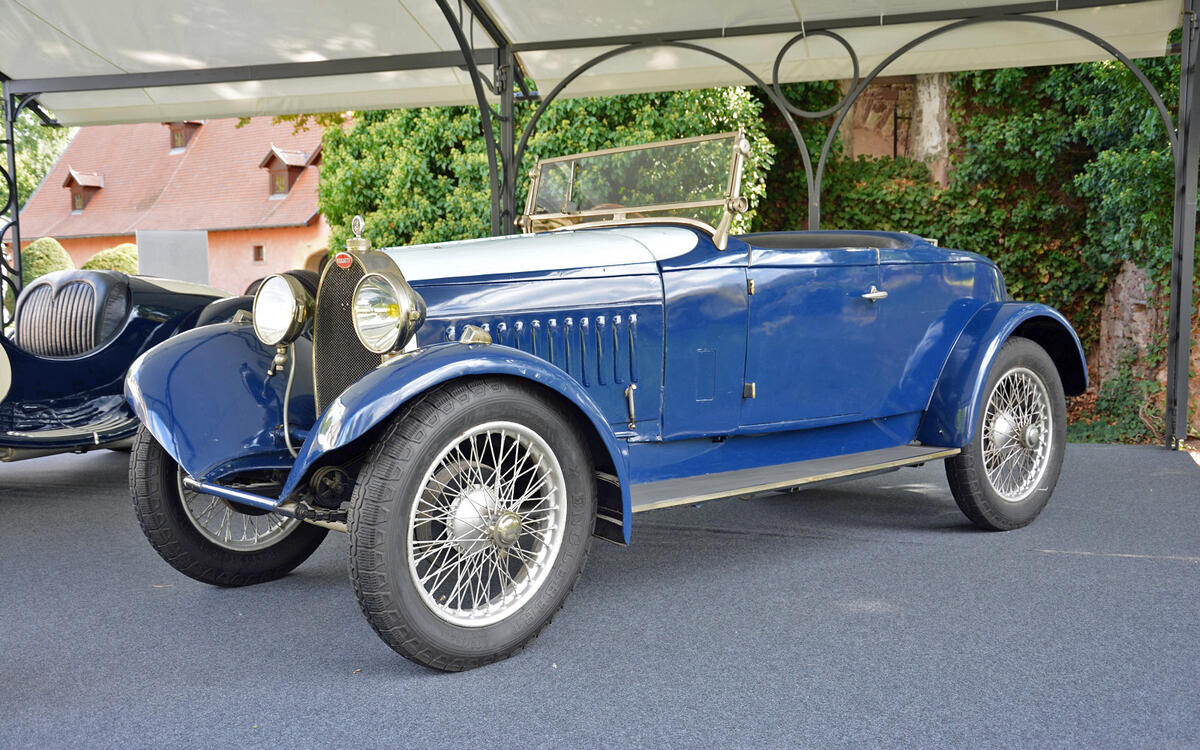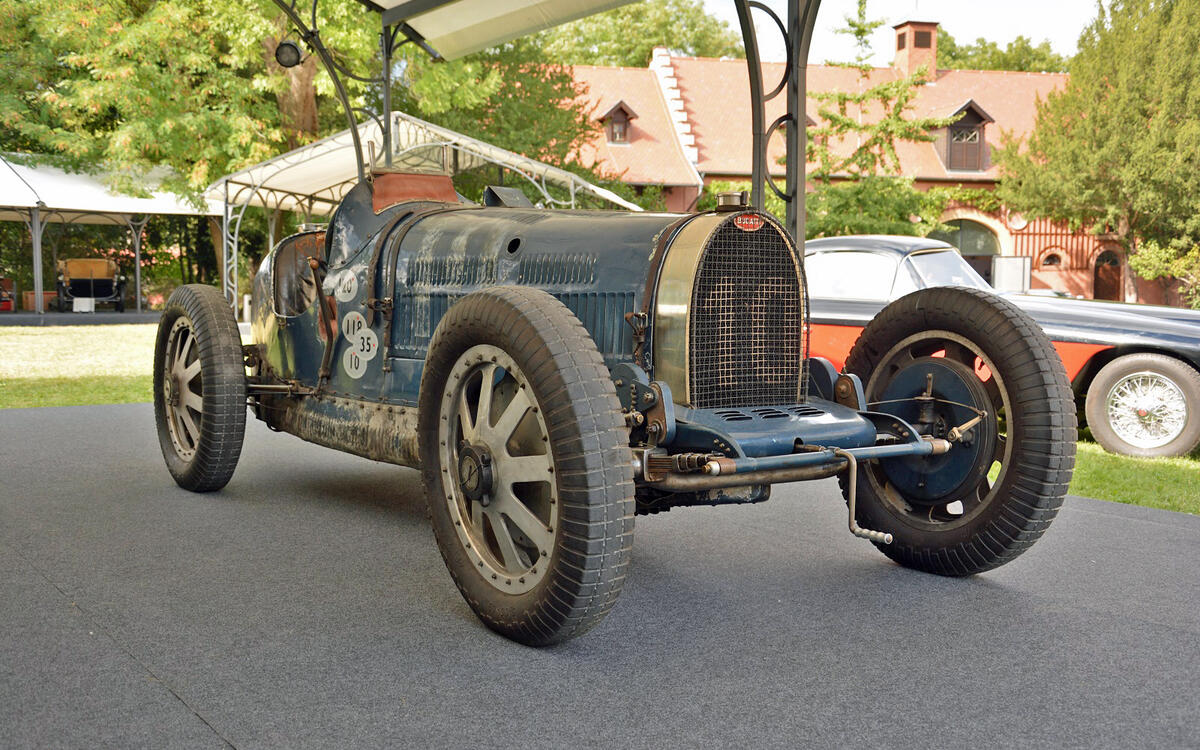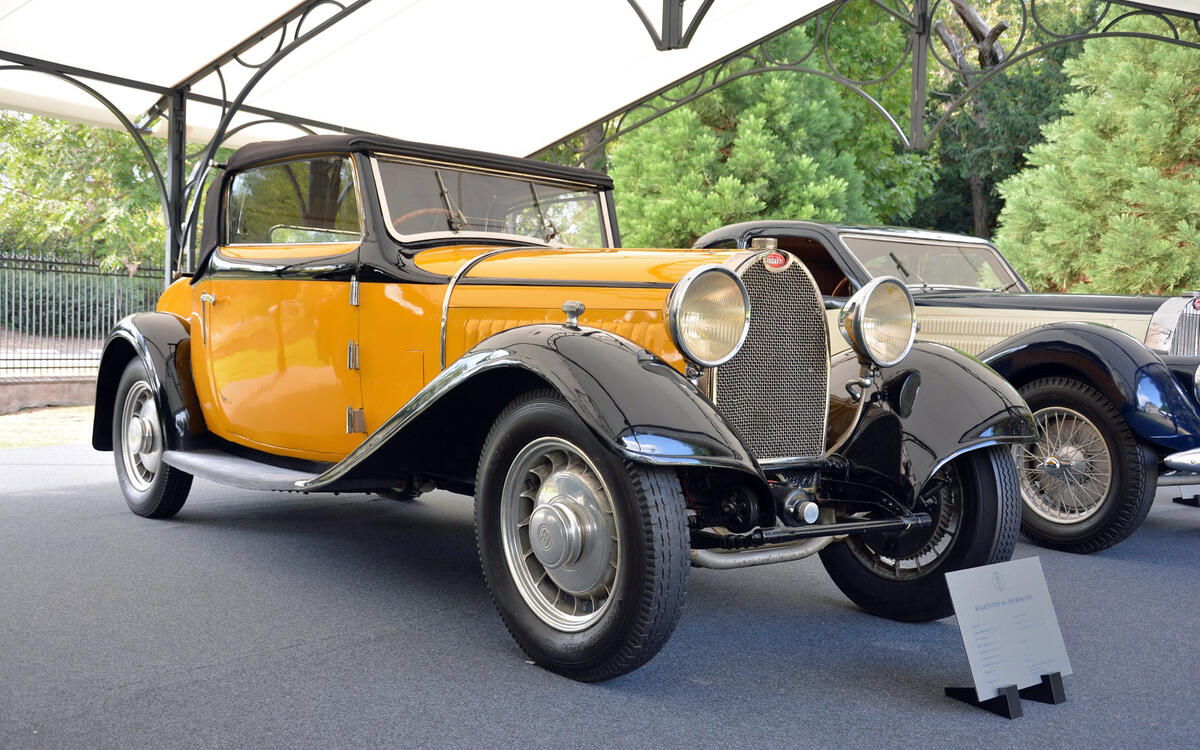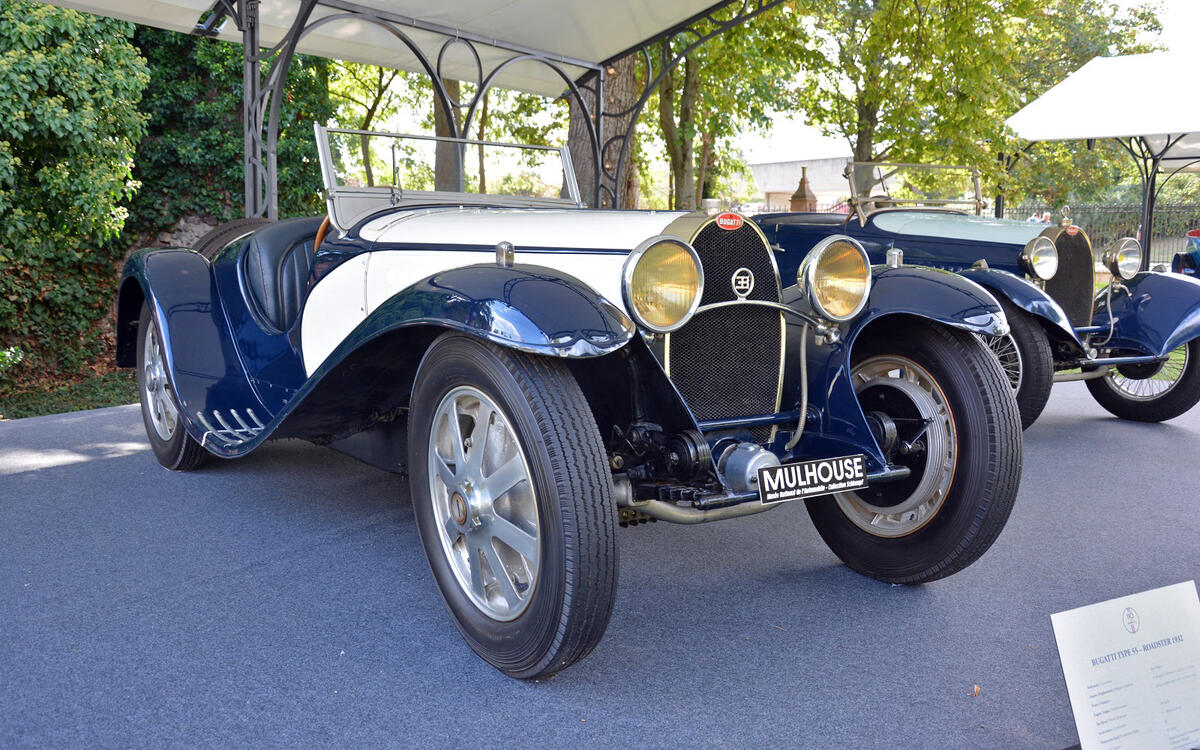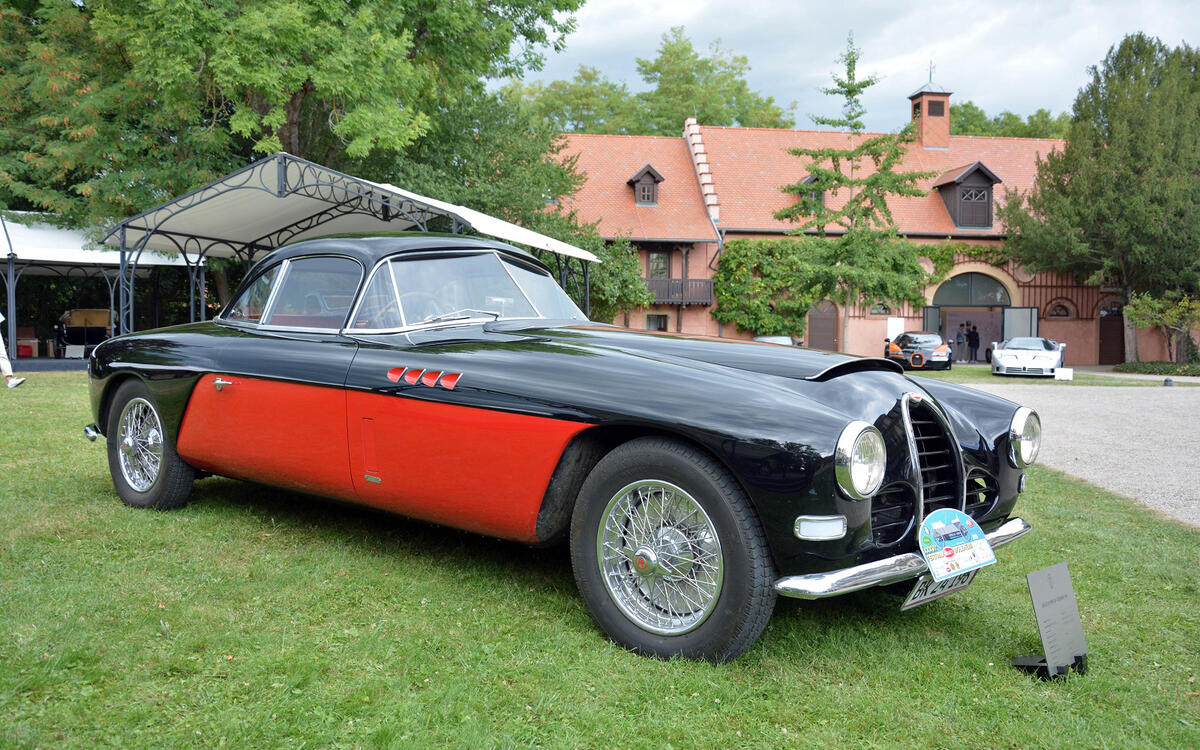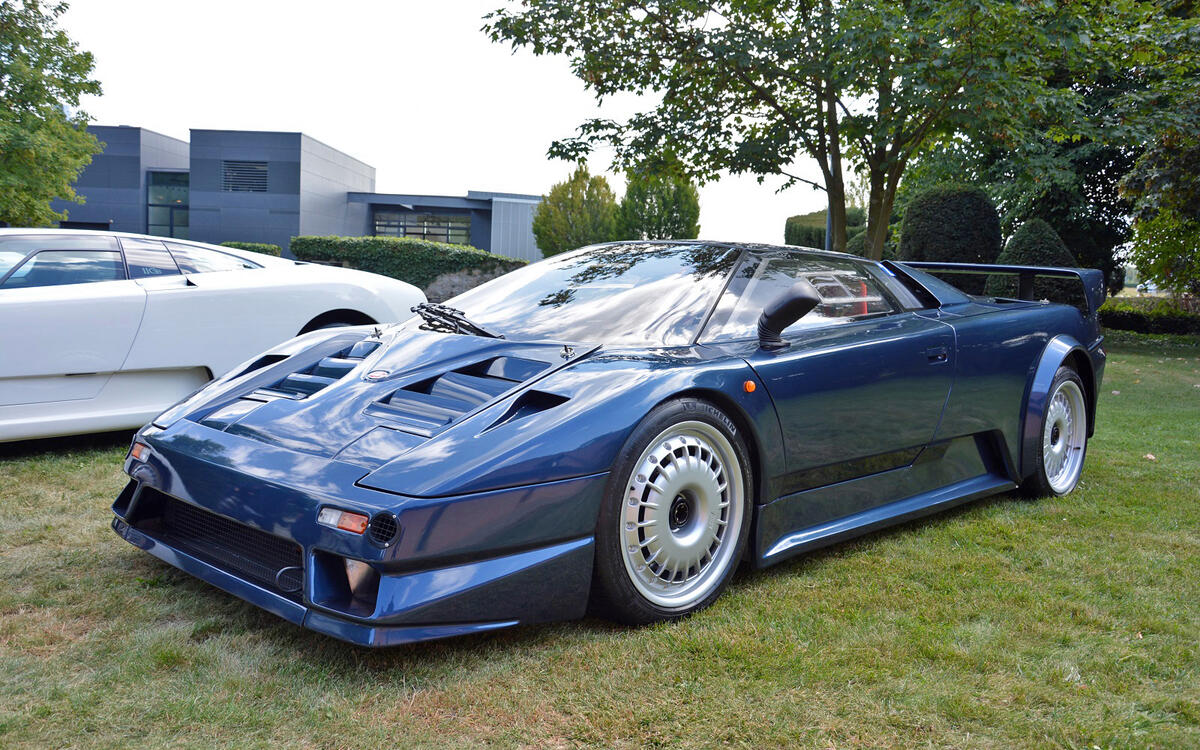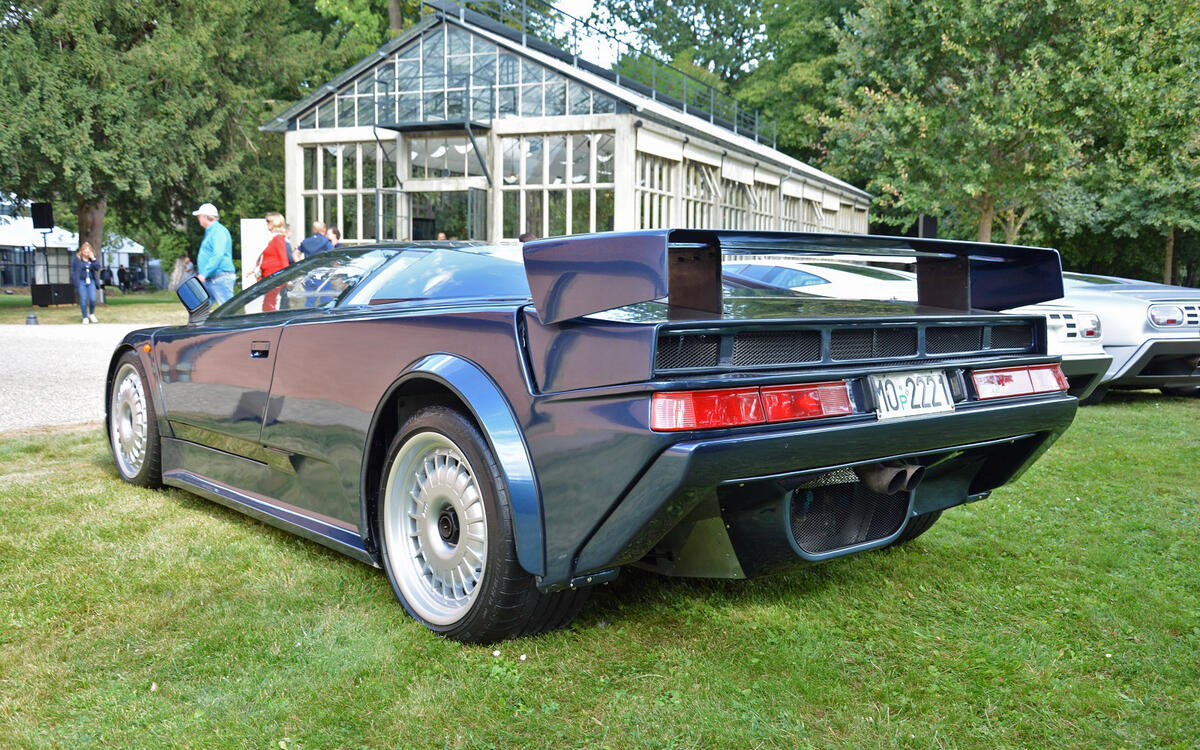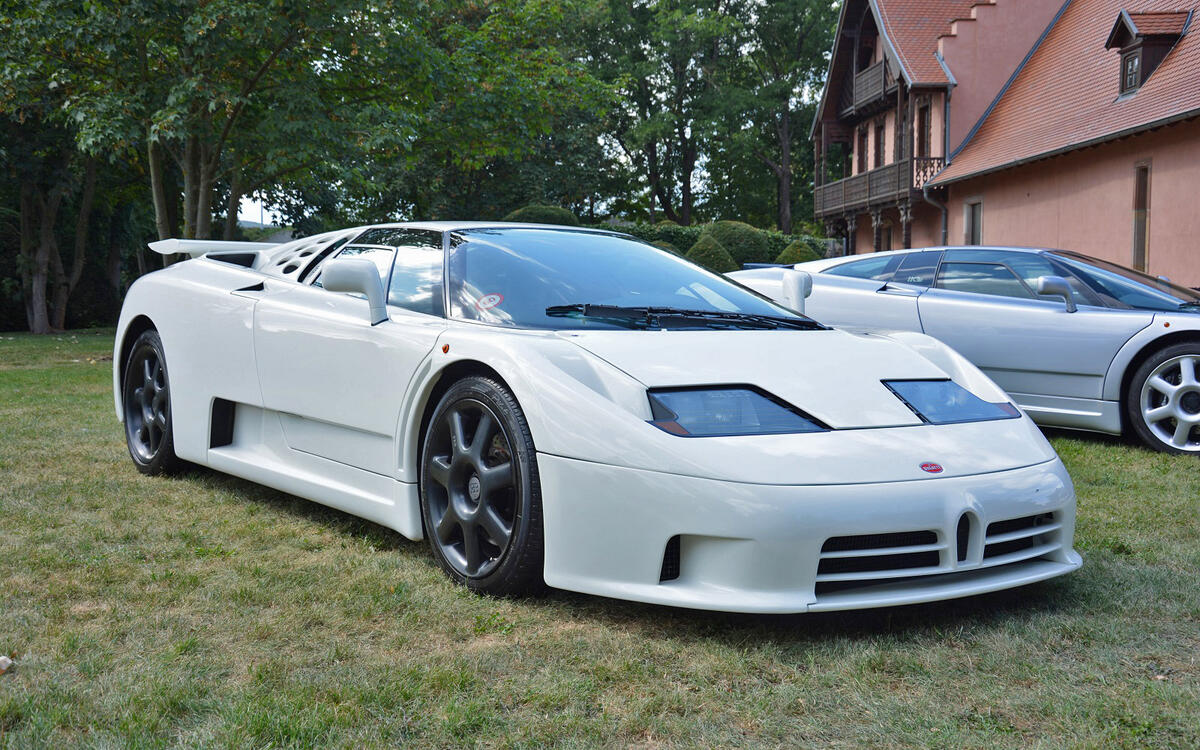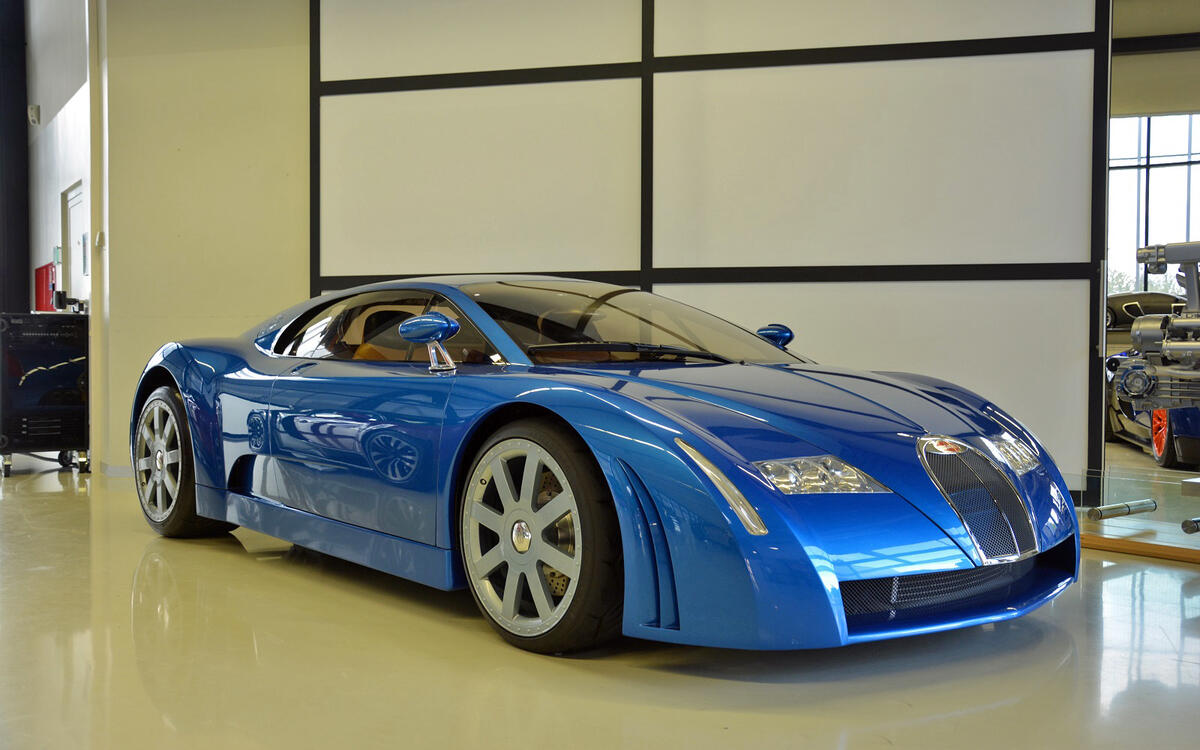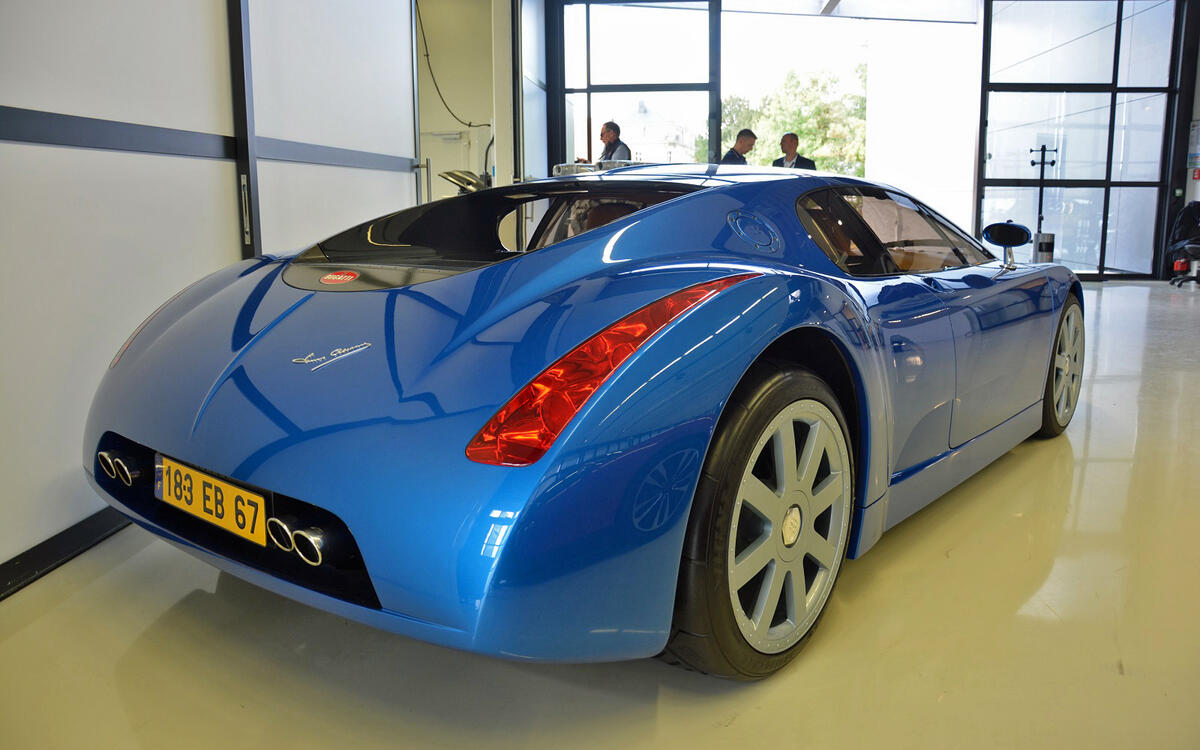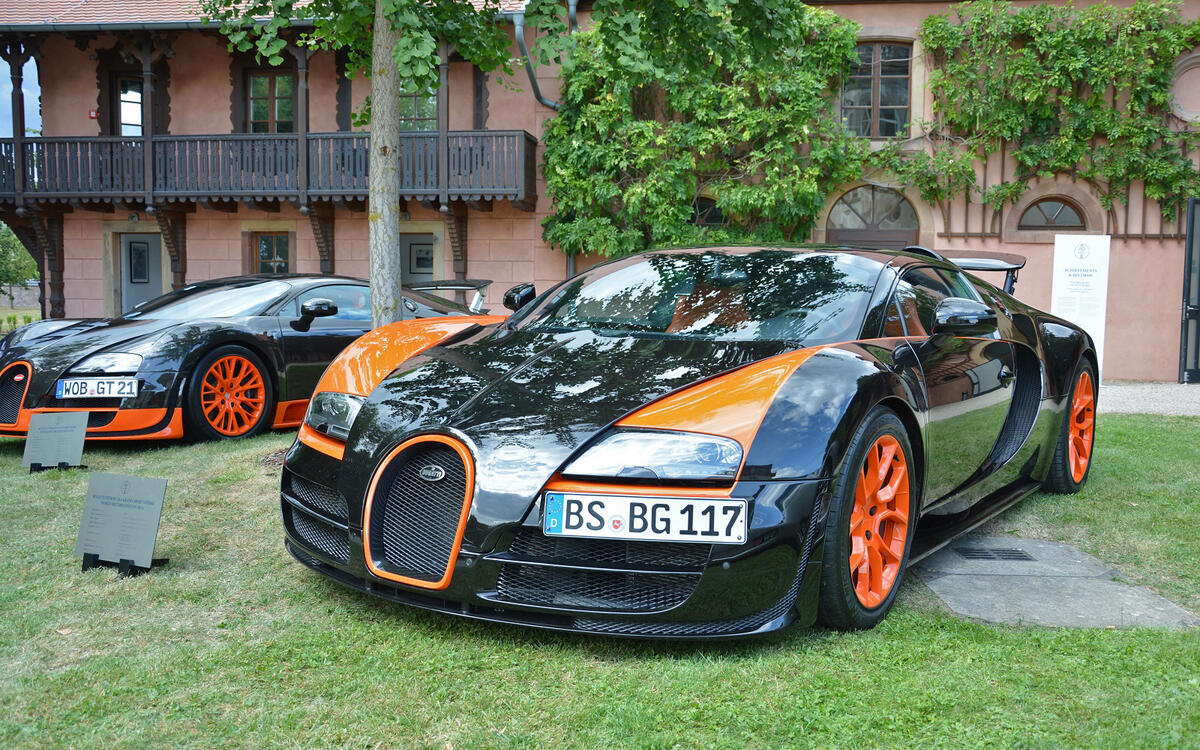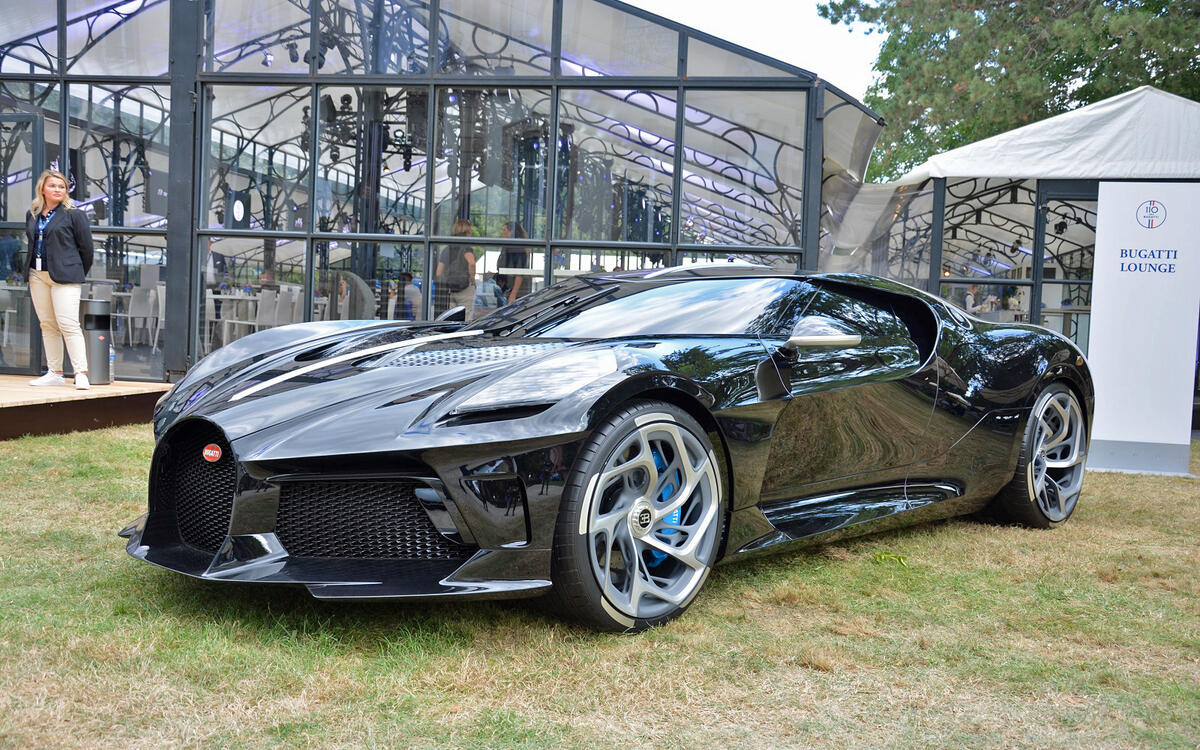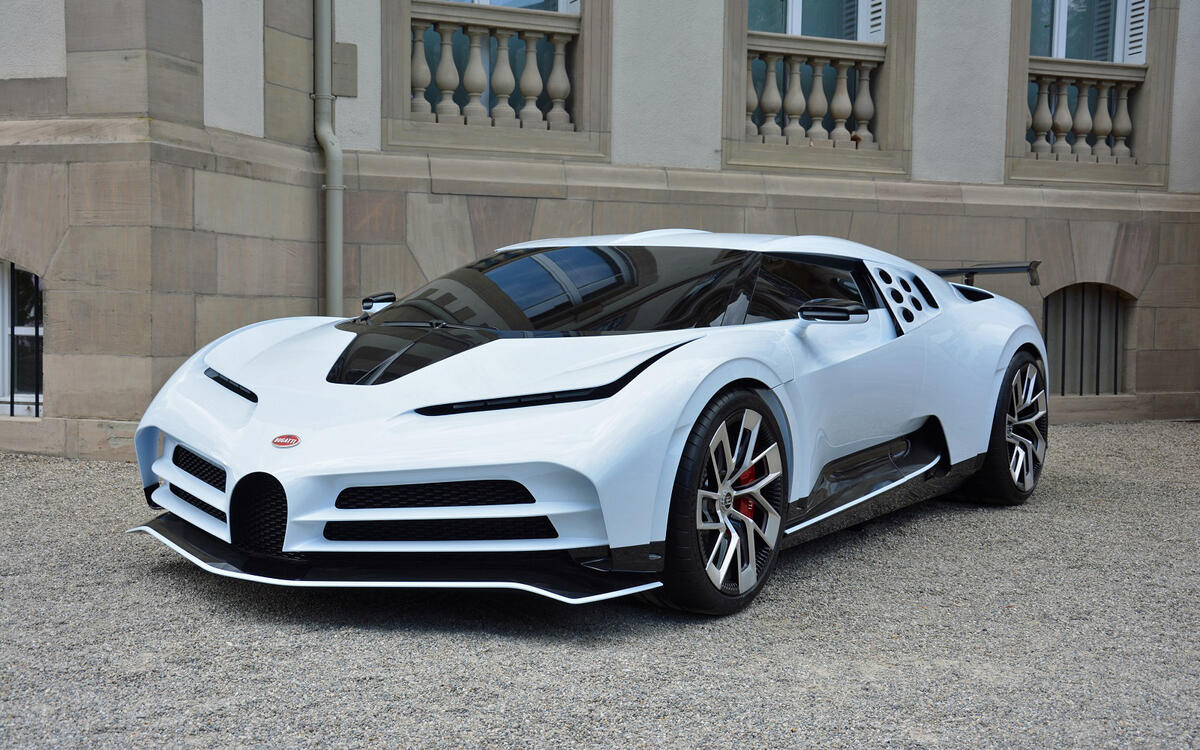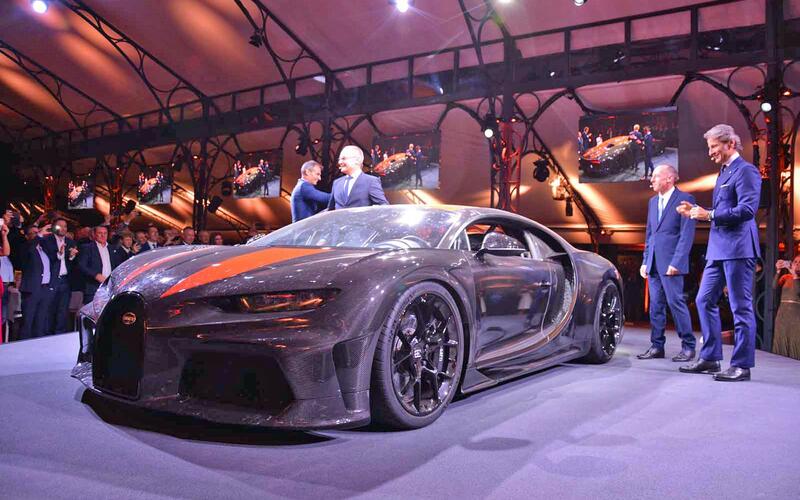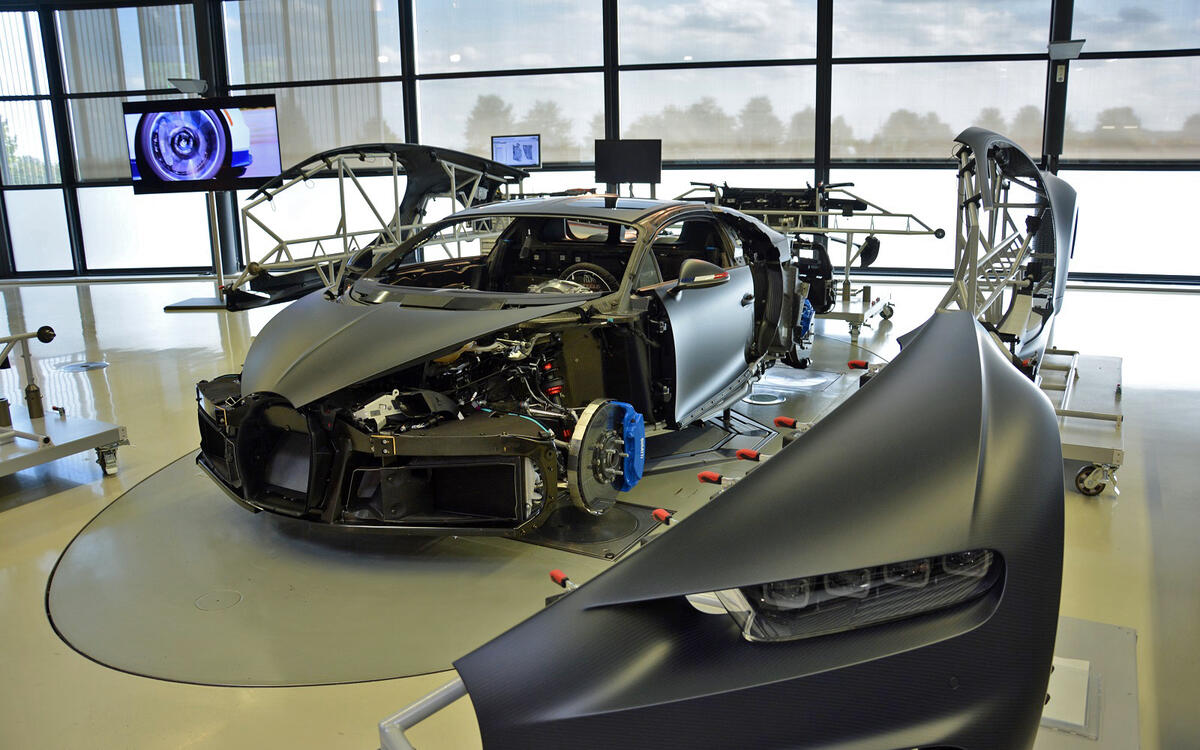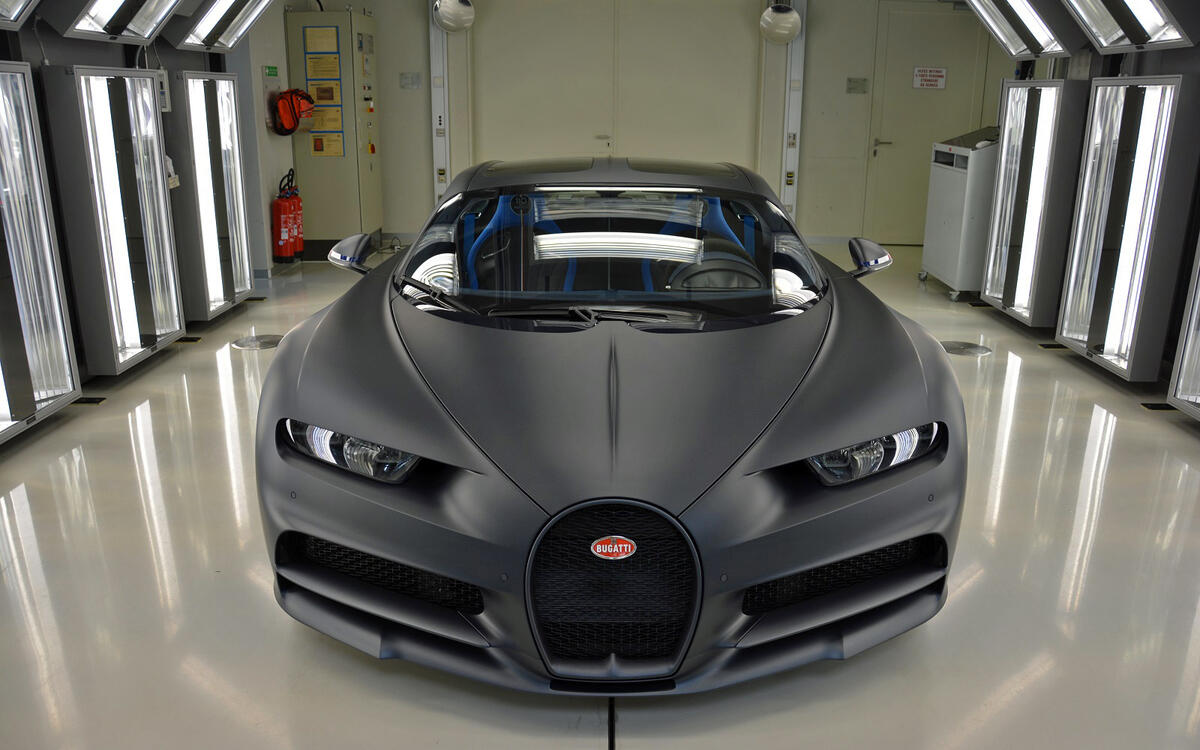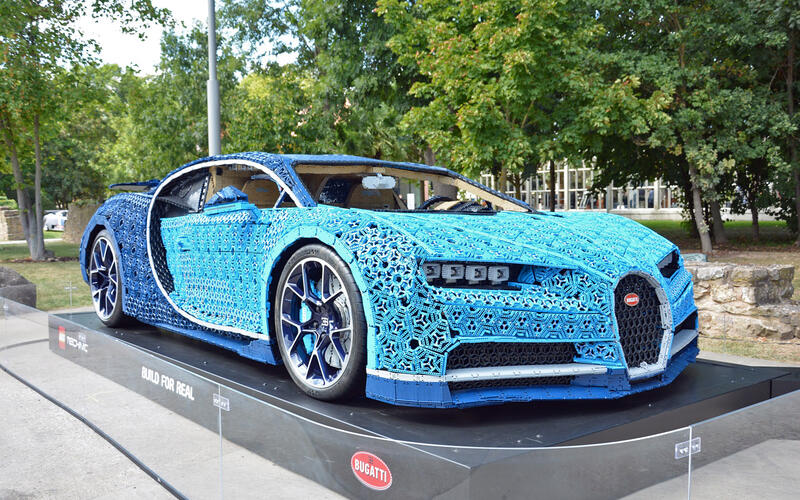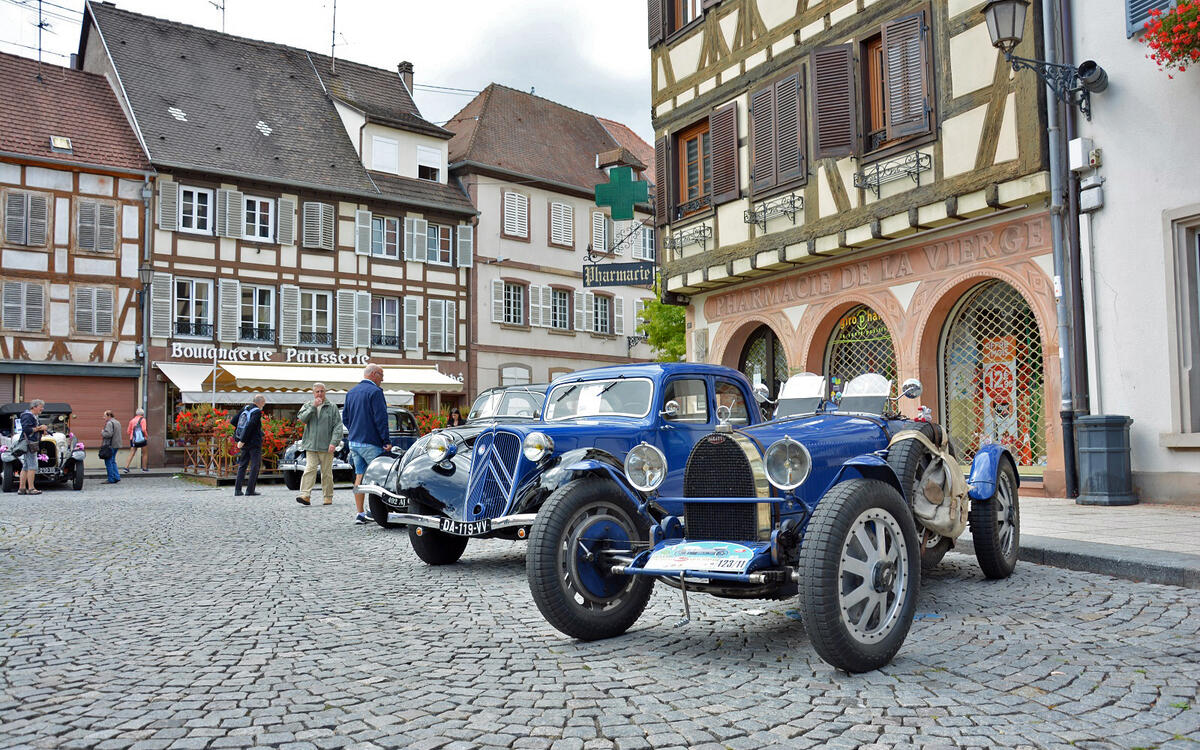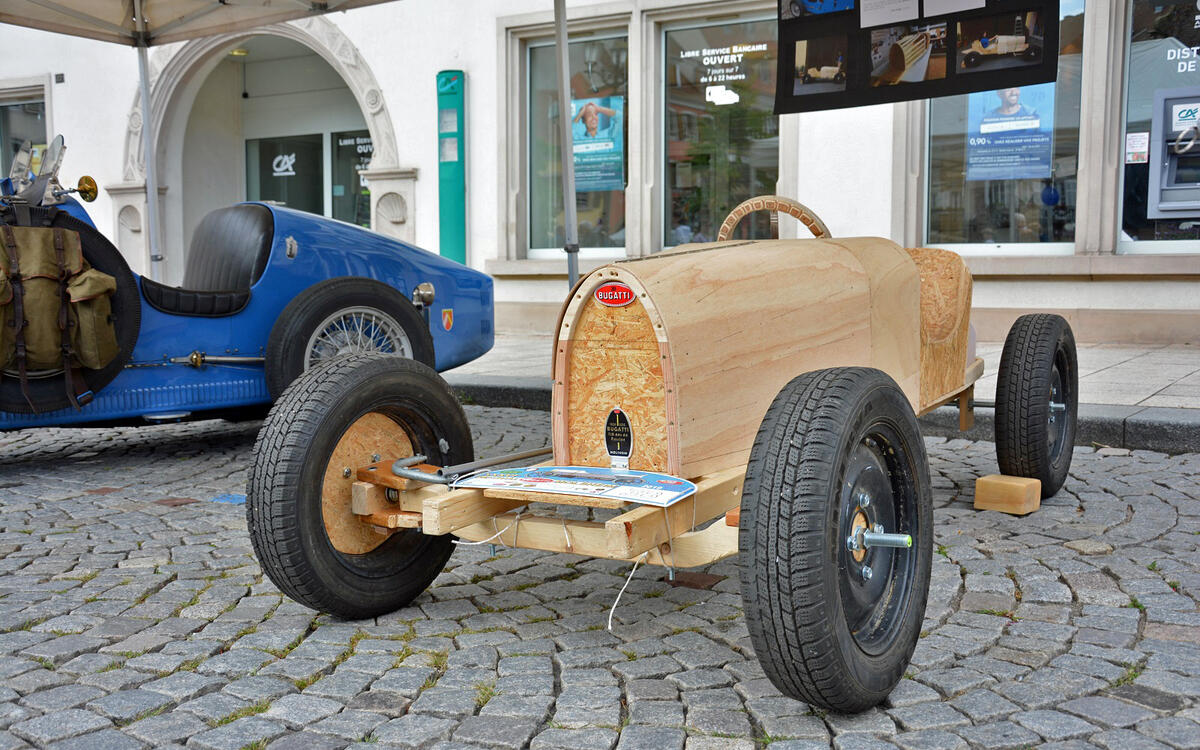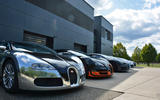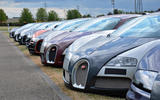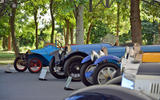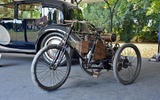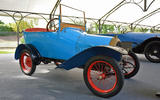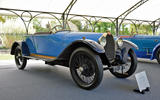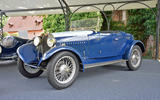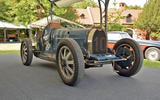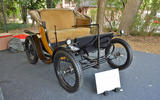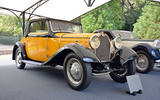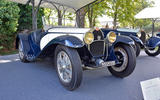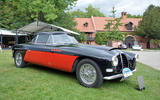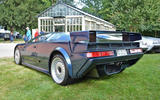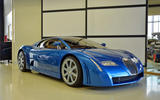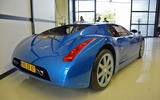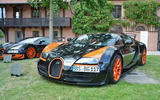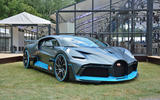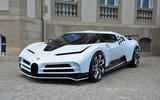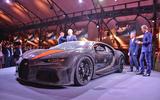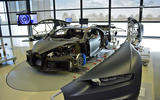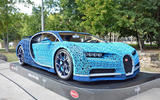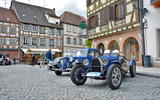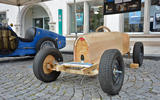 Slide of
Slide of
For a long time, it looked like Bugatti would never get the chance to celebrate its 110th birthday.
The French carmaker shut down twice: once in 1963 and again in 1995. Most of the car companies that close remain in the pantheon of automotive history but Bugatti unexpectedly made a second comeback when the Volkswagen Group purchased it in 1998. The name is too hallowed to gather dust and then-Volkswagen chieftain Ferdinand Piëch knew the firm had an immense amount of untapped potential.
Bugatti went to great lengths to show every facet of its history during the giant birthday party it organized at its historic headquarters in Molsheim, France. Autocar was on location to take it all in:
 Slide of
Slide of
Road-tripping
Bugatti organized its 110th birthday celebration as a way to spend a few days with its most loyal clients. They’re more than ordinary customers; they’re the company’s biggest fans. For some, the event started in Milan, Italy, where over a dozen owners met to embark on a fast-paced road trip across Europe.
The convoy drove to the sunny south of France before heading north towards Paris and east to Molsheim, a town located about 25 minutes away from Strasbourg. The trek ended right in front of the glass-walled factory that most of the cars were born in.
 Slide of
Slide of
Family tradition
We say most of the cars were born in Molsheim because a handful of Italian-built EB 110s participated in the road trip. There were also over a dozen examples of the Chiron in the convoy and nearly every variant of the Veyron released during the model’s production run. The EB 110, the Veyron and the Chiron represent different eras, both technically and for Bugatti as a brand, yet they have a lot in common.
 Slide of
Slide of
The Bugatti story
Recent models don’t fully tell the brand’s story so Bugatti held a classic car show right next to its factory, in front of the castle company founder Ettore purchased when he moved from Milan to Molsheim. It brought together cars from its own collection, from the Schlumpf museum in nearby Mulhouse and from private owners scattered across Europe.
The line-up included the usual suspects, like a Type 35, and a few more obscure models including a tricycle, a tiny Peugeot and an electric Bugatti.
 Slide of
Slide of
Prinetti & Stucchi Tipo 1 (1899)
Prinetti & Stucchi made tricycles and quadricycles in Milan, Italy, the home town of Ettore Bugatti. He worked for the firm as an engineer and notably developed the Tipo 1. Envisioned to race, it was powered by a pair of De Dion-Bouton engines mounted over the rear axle. It later set a world record by covering about 53 miles in 78 minutes.
 Slide of
Slide of
Peugeot Type 19 BB (1913)
At first glance, it looks like this Peugeot Type 19 BB snuck into the event on account of its blue paint. It’s surprising to see but it has every right to be at Bugatti’s headquarters. It started life as the Bugatti Type 19, a small two-seater that Ettore wanted to sell to a bigger manufacturer. Peugeot purchased it in 1911, made several small changes to the design and manufactured it between 1913 and 1916.
Peugeot made about 3000 units of the Type 19 BB.
 Slide of
Slide of
Bugatti Type 30 Touring (1925)
While the Type 30 earned a prominent spot in Bugatti’s history due to its racing success, it was also a road-legal car that put motorsport technology in the hands of ordinary motorists. If this sounds familiar, it’s because carmakers still successfully use this formula to sell cars in 2019.
Bugatti made about 600 units of the Type 30 and the Type 30 A. The example shown here wears a body made by Wiederkehr-Gangloff in Colmar, France, a town about an hour south of Molsheim. Its 2.0-litre straight-eight engine delivers 64bhp, which is enough for a 75mph top speed.
 Slide of
Slide of
Bugatti Type 40 A Roadster (1926)
Bugatti developed the Type 40 to replace the Brescia, which is widely considered its first car. Released in 1926, the Type 40 stood out as a relatively small model powered by a detuned version of the Type 37 race car’s engine. The 1.5-litre four-cylinder made 49bhp, which was plenty in the 1920s.
830 examples of the Type 40 were made. The one pictured wears a body designed by Jean Bugatti but buyers who wanted a custom-designed car could commission one from over a dozen coachbuilders.
 Slide of
Slide of
Bugatti Type 35C (1929)
Albert Divo won the 1929 edition of the Targa Florio race in this Bugatti Type 35C. It then spent decades racing in Scandinavia, often on frozen lakes, and numerous battle scars add credibility to its story. This car was maintained and rebuilt several times but it has never been fully restored; it’s one of the most original Type 35s left and easily one of the most interesting cars displayed at Bugatti’s 110th birthday.
 Slide of
Slide of
Bugatti Type 56 (1931)
The Type 56 is the first, last and only electric Bugatti. Ettore built it in 1931 to drive around his property. It didn’t need to look good or go fast; it only had to cover short distances at a leisurely pace. Power came from an electric motor that was related to the electric starter Bugatti fitted on its bigger cars.
Bugatti planned to build one example of the Type 56 but the carriage-like runabout took customers by surprise when they traveled to Molsheim to pick up a car. King Leopold III of Belgium notably bought one for his wife Astrid. The one-off Type 56 turned into a few-off model by popular request. 10 units were made between 1931 and 1936 and four of those remain in 2019, including the unrestored example (pictured) that lives in Bugatti’s collection. Rumors claim a fifth one is hidden somewhere in Canada.
 Slide of
Slide of
Bugatti Type 49 Touring (1931)
The Type 49 received the biggest evolution of Bugatti’s early straight-eight engine. Bumping the displacement up to 3.3 litres unlocked 108bhp, which was enough to give the car a top speed of 80mph. The only way for Bugatti buyers to go faster was to upgrade to a supercharged car like the Type 43.
470 examples of the Type 49 were made.
 Slide of
Slide of
Bugatti Type 55 Roadster (1932)
The saying that claims “what wins on Sunday sells on Monday” was also true during the 1930s. The Type 55 that Bugatti released in 1932 was closely related to the Type 51 that won the 1931 French Grand Prix. The firm made several changes to the model before manufacturing it for the general public. Buyers could order the Type 55 with a body designed by Jean Bugatti or send the chassis to an outside coachbuilder. Either way, power came from a 2.3-litre straight-eight supercharged to 158bhp.
38 cars were built between 1932 and 1935.
 Slide of
Slide of
Bugatti Type 101 Turismo (1953)
The Type 101 represented a bold attempt to breathe new life into Bugatti after the deaths of company founder Ettore and his son Jean. The firm couldn’t afford to develop a new car from scratch so dusted off the parts it had available and hoped coachbuilders would take care of the rest. The Type 101 borrowed its frame and its straight-eight engine from the Type 57 made before WWII.
Bugatti sold six units of the Type 101 plus one 57/101 chassis. This privately-owned example wears a body manufactured by Antem. The Type 101 was the last production model Bugatti made before it shut down in 1963. The firm developed other cars during the 1950s, including the Type 252, but they remained at the prototype stage.
For decades, it looked like Bugatti was doomed to exist only in history books.
 Slide of
Slide of
Bugatti A35 02 prototype (1991)
In the late 1980s, Italian entrepreneur Romano Artioli (Born 1932) enlisted designer Marcello Gandini to help create a Bugatti for the 1990s. The move made sense; Gandini was already one of the most respected names in car design and his resume included dozens of cars like the Lamborghini Miura, Lancia Stratos, the first-generation BMW 5 Series and the Citroën BX. Gandini could do it all and he did it well.
The idea wasn’t to make a retro-inspired car. Unrestrained by heritage, Gandini’s proposal took the form of an angular, wedge-shaped coupe characterized by pop-up headlights and numerous vents. The horseshoe-shaped grille was notably missing. Out back, it wore lights from the Alfa Romeo 164.
 Slide of
Slide of
Bugatti A35 02 prototype (1991)
Artioli turned down Gandini, something few executives have ever dared to do. He didn’t like the prototype, which was called A35, and instead asked architect Giampaolo Benedini to create the final design. Benedini had never worked as an automotive designer before; his contribution to the Bugatti resurrection was initially limited to drawing the cutting-edge blue factory and the adjacent buildings.
The EB 110 remained wedge-shaped but Benedini made significant changes to the overall design. On paper, however, the two cars were a lot alike. The A35 used a mid-mounted, 3.5-litre V12 tuned to send 552bhp to the four wheels. It had a top speed of 212mph.
 Slide of
Slide of
Bugatti EB 110 (1991)
Often forgotten, the EB 110 is the foundation that the modern-day Bugatti brand is built on. It’s a hugely powerful mid-engined coupe that exists at the intersection of sports cars and luxury cars. The model pictured here is a Super Sport (SS) variant with a 603bhp evolution of the quad-turbocharged, 3.5-litre V12. Permanent all-wheel drive helped the 12 channel its power to the ground.
Bugatti made 128 units of the EB 110 by hand. The company’s archives department indicates about 96 cars were made to GT specifications and 32 cars in SS trim.
 Slide of
Slide of
Bugatti 18/3 Chiron concept (1999)
Several factors conspired to shutter Bugatti in 1995. The name returned to the history book until the Volkswagen Group purchased it in 1998 with plans to transform it into its flagship brand. At first, many doubted the purveyors of the humble Golf could make a credible tribute to previous Bugatti models. The 18/3 Chiron concept unveiled at the 1999 Frankfurt motor show silenced critics and naysayers.
 Slide of
Slide of
Bugatti 18/3 Chiron concept (1999)
Envisioned as a successor to the EB 110, the 18/3 featured triple Xenon headlights, a body made entirely out of carbon fiber to keep weight in check plus a 540bhp, 6.3-litre W18 engine that was as complex as it was fascinating. This masterpiece of an engine consisted of three banks of six cylinders arranged in a W configuration. It sent the 18/3 Chiron to a top speed of 205mph.
 Slide of
Slide of
Bugatti Veyron Grand Sport Vitesse (2013)
The Veyron Grand Sport Vitesse was the roadster variant of Bugatti’s record-breaking Veyron Super Sport. Presented at the 2012 Geneva motor show, it was celebrated as the fastest and most powerful convertible in the world. Its 16-cylinder engine propelled it to a top speed of 253mph.
 Slide of
Slide of
Bugatti Divo (2018)
The limited-edition Divo introduced in 2018 illustrated Bugatti’s vision of modern coachbuilding. Starting with a Chiron, engineers tweaked the chassis, upgraded the brakes and removed mass to create a sharper, more track-focused supercar. The 40 examples planned were spoken for almost immediately.
 Slide of
Slide of
Bugatti La Voiture Noire (2019)
The La Voiture Noire is a one-off tribute to the Type 57SC Atlantic. It’s the most expensive car in the world, it allegedly sold for €11 million (around £9.7 million/$12 million) before taxes, and Bugatti plans to keep the buyer’s identity a secret.
The car hasn’t been built yet; the example you see here is a life-sized, non-functional replica made for auto shows and special events. We suspect the owner might reveal his or her identity after taking delivery in 2021.
 Slide of
Slide of
Bugatti Centodieci (2019)
Bugatti drew inspiration from the EB 110 to create the Centodieci. Limited to 10 examples, it’s based on the Chiron but it receives a new body as well as a 1578bhp evolution of the quad-turbocharged W16 engine.
The Centodieci helps Bugatti celebrate its 110th birthday and it proudly declares the company considers the EB 110 a legitimate part of its heritage. Customers agree with this assessment and the 10 examples were claimed well before the Centodieci made its public debut in 2019.
 Slide of
Slide of
Bugatti Chiron Super Sport 300+ (2019)
The limited-edition Chiron Super Sport 300+ unexpectedly made its public debut during the dinner that followed Bugatti’s 110th birthday celebrations. It’s a road-going variant of the car British pilot Andy Wallace recently drove to 304mph on Volkswagen’s Ehra-Lessien test track.
Bugatti’s most loyal clients were in attendance so the 30 units planned were spoken for by the end of the evening. One man told us he bought two examples; one to drive and the other to keep in like-new condition.
 Slide of
Slide of
Inside the Atelier
Bugatti rarely lets the public step inside its factory, which it calls the Atelier. It made a rare exception during its 110th birthday. After hiding the secret projects it’s working on, it moved cars and machines out of the way to create an open space that let attendees discover how a Chiron comes to life. It detailed nearly every step of the process, from installing the W16 engine to choosing the upholstery.
 Slide of
Slide of
The 12-step process
You won’t find an automated production line in Molsheim. Assembled by hand, every car travels through 12 stations, including one where the engine is bolted to the transmission and another where workers spend about three days installing the body panels and adjusting them to perfection. Cars are only eligible for delivery once they’re absolutely flawless.
 Slide of
Slide of
Life-sized Lego Chiron
This Chiron was hand-assembled, but not in Molsheim. Life-sized and fully functional, it’s made with over one million Lego Technic pieces. An electric motor powers it to a top speed of more than 12mph, which is plenty considering it’s held together like a standard Lego kit. No glue was used during the assembly process. Developing and building the car took over 13,000 hours, according to Bugatti.
 Slide of
Slide of
Molsheim’s show
The celebrations continued in the heart of Molsheim, where Bugatti is the official language. Streets closed to traffic morphed into an outdoors car show where race-winning vintage Bugatti models wowed the crowd next to more humble classics made by brands like Renault and Citroën. The architecture hasn’t changed significantly during the past century so walking through town felt like traveling in time.
 Slide of
Slide of
Wooden Type 35
One of the most interesting cars displayed in Molsheim was this wooden, scaled-down replica of a Type 35. Built from scratch, it’s an on-going project that a 12-year old girl and her dad hope to finish by the spring of 2020. There’s no word on what will power the model yet.
As part of Bugatti’s big birthday celebrations we take a tour of its greatest cars
Advertisement



